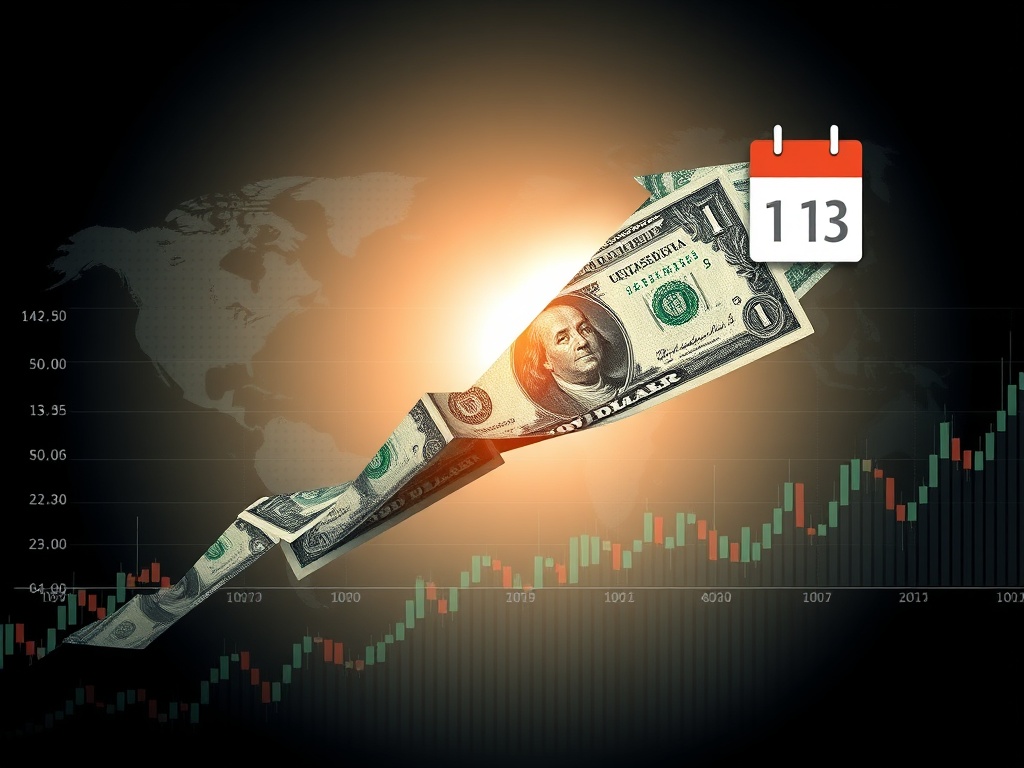BitcoinWorld

US Dollar Surges: A Crucial Week for Global Economy and Non-Farm Payrolls
The financial world is abuzz as the US Dollar marks an extraordinary milestone, poised for its best weekly performance in three years. This significant surge is not just a headline for currency traders; it sends ripples across every corner of the financial landscape, including the volatile realm of cryptocurrencies. For those invested in digital assets, understanding the underlying forces driving this dollar dominance is paramount, as macro-economic shifts often dictate the ebb and flow of capital in and out of riskier assets like Bitcoin and altcoins. What’s truly driving this impressive run, and how will the highly anticipated Non-Farm Payrolls report shape its future trajectory and the broader global economy?
Understanding the Unprecedented US Dollar Surge
The recent ascent of the US Dollar has been nothing short of remarkable, captivating analysts and investors alike. Its journey to becoming the strongest performer among major currencies this week is a culmination of several powerful economic and geopolitical factors. This isn’t just about a single event; it’s about a confluence of circumstances that have positioned the dollar as a preferred asset globally.
What are the primary catalysts behind this impressive Dollar strength?
- Interest Rate Differentials: The Federal Reserve’s proactive stance on monetary policy has played a pivotal role. While other major central banks, like the European Central Bank or the Bank of Japan, have maintained a more cautious or dovish approach, the Fed has been relatively more aggressive in its efforts to combat inflation. Higher interest rates in the US make dollar-denominated assets more attractive to international investors seeking better returns. This creates a ‘carry trade’ opportunity, where investors borrow in low-interest currencies and invest in higher-interest dollar assets, driving up demand for the greenback.
- Safe-Haven Demand: In times of heightened global uncertainty, whether stemming from geopolitical tensions, economic slowdown fears in major economies like China or Europe, or financial market volatility, the US Dollar traditionally acts as a safe haven. Investors flock to the dollar, US Treasuries, and other dollar-denominated assets as a store of value, perceiving them as less risky during turbulent periods. This flight to quality inherently boosts dollar demand.
- US Economic Resilience: Despite global headwinds, the US economy has shown surprising resilience. Robust labor market data, consistent consumer spending, and relatively stable corporate earnings have painted a picture of an economy that, while facing challenges, is performing better than many of its global counterparts. This relative strength makes the US an attractive destination for foreign investment, further bolstering the dollar.
Comparing the dollar’s performance against other major currencies, such as the Euro, Japanese Yen, and British Pound, highlights this divergence. The Euro has grappled with recession fears and energy crises, the Yen with ultra-loose monetary policy, and the Pound with its own set of inflation and growth challenges. Against this backdrop, the dollar’s relative appeal has intensified, cementing its position as a dominant force in the forex market.
The Pivotal Role of Non-Farm Payrolls: What to Expect?
While the factors above provide a foundation for the dollar’s current strength, all eyes are now firmly fixed on the upcoming Non-Farm Payrolls (NFP) report. This monthly release from the US Department of Labor is arguably one of the most anticipated and impactful pieces of economic data on the global calendar.
What exactly are Non-Farm Payrolls? The NFP report provides a comprehensive snapshot of the health of the US labor market, specifically measuring the number of new jobs created in the non-agricultural sectors during the previous month. It also includes crucial details such as the unemployment rate and average hourly earnings, which are key indicators of wage inflation. For policymakers at the Federal Reserve, the NFP is a critical input for their monetary policy decisions, as a strong labor market can signal inflationary pressures, potentially prompting further interest rate hikes.
The market’s hypersensitivity to the NFP data stems from its direct implications for interest rates. A robust NFP report, indicating strong job growth, often leads to expectations of higher interest rates, which in turn strengthens the dollar. Conversely, a weak report can signal economic slowdown, leading to expectations of lower rates or even rate cuts, thereby weakening the dollar.
Let’s consider the potential scenarios for the upcoming NFP report and their likely impact:
| NFP Result | Interpretation | Expected Dollar Reaction | Fed Policy Implication |
|---|---|---|---|
| Strong NFP (Above Expectations) | Robust job growth, potential inflationary pressure. | Significant Dollar strength, bond yields rise. | Increases likelihood of further rate hikes. |
| Weak NFP (Below Expectations) | Slowing job market, economic slowdown concerns. | US Dollar weakness, bond yields fall. | Decreases likelihood of rate hikes, raises possibility of cuts. |
| Mixed NFP (e.g., strong jobs, weak wages) | Nuanced outlook, market uncertainty. | Initial volatility, then reaction based on dominant factor. | Fed maintains ‘data-dependent’ stance, market seeks clarity. |
The market will not only focus on the headline jobs number but also scrutinize average hourly earnings, as wage growth is a direct indicator of inflationary pressures. A higher-than-expected wage growth, even with moderate job creation, can still fuel dollar strength by signaling persistent inflation.
Beyond Payrolls: How Broader Economic Data Fuels Dollar Strength
While Non-Farm Payrolls capture immediate attention, the dollar’s sustained strength is also deeply rooted in a broader array of economic data. These indicators collectively paint a comprehensive picture of the US economy’s health relative to the rest of the global economy, influencing investor sentiment and capital flows.
What other crucial economic indicators are at play?
- Inflation Data (CPI, PPI): The Consumer Price Index (CPI) and Producer Price Index (PPI) measure inflation at the consumer and producer levels, respectively. Persistent high inflation figures in the US, especially when compared to more subdued inflation in other major economies, reinforce the Federal Reserve’s need to maintain a hawkish stance, supporting the dollar.
- Gross Domestic Product (GDP) Growth: GDP measures the total economic output of a country. Strong GDP growth indicates a healthy and expanding economy, which attracts foreign investment and strengthens the national currency. If the US consistently outperforms other major economies in terms of growth, it naturally bolsters the dollar.
- Retail Sales: This report tracks consumer spending, a significant component of GDP in consumer-driven economies like the US. Robust retail sales suggest strong consumer confidence and economic momentum, contributing to positive economic outlook and dollar appreciation.
- Manufacturing and Services PMIs: Purchasing Managers’ Indexes (PMIs) for both manufacturing and services sectors are leading indicators of economic activity. Strong PMI readings suggest expanding business activity, job creation, and future economic growth, providing further support for the US Dollar.
- Consumer Confidence: Surveys measuring consumer sentiment about current and future economic conditions can provide insights into spending patterns. High consumer confidence often translates to increased spending, contributing to economic growth.
The Federal Reserve’s approach is often described as ‘data-dependent.’ This means their decisions on interest rates and monetary policy are heavily influenced by the latest incoming economic statistics. If the aggregate of these data points suggests persistent inflation and a resilient economy, the Fed is more likely to continue with tighter monetary policy, which, in turn, underpins Dollar strength. Conversely, signs of significant economic weakness across these indicators could prompt a pivot towards a more dovish stance, potentially softening the dollar’s rally.
Understanding this intricate web of economic indicators is essential for anyone tracking the dollar, as it’s not just about one report but the cumulative weight of all data points shaping the Fed’s outlook and, consequently, the dollar’s value.
The Ripple Effect: How Dollar Strength Impacts the Global Economy and Your Portfolio
The formidable Dollar strength we are witnessing does not occur in a vacuum; its effects reverberate throughout the entire global economy, creating winners and losers, and significantly influencing various asset classes, including the increasingly interconnected cryptocurrency markets.
How does a strong dollar ripple through the global financial system?
- Impact on Emerging Markets: Many emerging market countries and corporations have dollar-denominated debt. As the dollar strengthens, the cost of servicing and repaying this debt increases significantly in their local currencies. This can lead to financial strain, capital outflows, and even sovereign debt crises in vulnerable economies.
- Commodities Pricing: Major commodities like oil, gold, and industrial metals are typically priced in US Dollars. When the dollar strengthens, these commodities become more expensive for buyers using other currencies, which can lead to a decrease in demand and, consequently, lower commodity prices in dollar terms. This inverse relationship is a critical dynamic for commodity-exporting nations and global inflation.
- International Trade: A strong dollar makes US exports more expensive for foreign buyers, potentially reducing demand for American goods and services. Conversely, it makes imports cheaper for US consumers, which can lead to an increase in imports and potentially widen the US trade deficit.
- Corporate Earnings for Multinationals: US-based multinational corporations that generate a significant portion of their revenue overseas often see their foreign earnings devalued when converted back into a stronger dollar. This can negatively impact their reported earnings and stock performance.
Is Your Crypto Portfolio Prepared for Sustained Dollar Dominance?
For cryptocurrency investors, the dollar’s ascendancy is a particularly important trend to monitor. While crypto markets often operate on their own unique narratives, they are not immune to macro-economic forces. A strong dollar typically correlates with a ‘risk-off’ sentiment in global markets.
- Risk-Off Sentiment: When global economic uncertainty rises and the dollar acts as a safe haven, investors tend to reduce their exposure to riskier assets. Cryptocurrencies, despite their innovative nature, are still largely perceived as high-risk, high-reward investments. This means capital can flow out of crypto into more traditional, safer assets like the dollar and US Treasuries.
- Liquidity Drain: A strong dollar can absorb liquidity from other markets. If investors are selling assets denominated in other currencies to buy dollars, or simply holding cash in dollars, it can reduce the available capital for investment in more speculative markets, including crypto.
- Stablecoin Dynamics: While stablecoins like USDT or USDC are pegged to the US Dollar, their underlying collateral and the regulatory environment surrounding them are still subject to scrutiny. A strong dollar doesn’t directly impact their peg but highlights the reliance of the crypto ecosystem on the stability of fiat currencies.
Understanding these correlations is vital. While Bitcoin has often been touted as ‘digital gold’ and an inflation hedge, its performance in recent periods of dollar strength suggests it still largely behaves as a risk asset, sensitive to broader macroeconomic shifts.
Navigating a Dominant US Dollar: Actionable Insights for Investors
In a world where the US Dollar is demonstrating formidable Dollar strength, investors across various asset classes must adapt their strategies. Whether you’re a seasoned forex trader, an equity investor, or deeply entrenched in the cryptocurrency space, understanding how to navigate this environment is key to protecting and growing your capital.
For Forex Traders:
- Monitor Interest Rate Differentials: Keep a close eye on central bank policies globally. The widening gap between US interest rates and those of other major economies will continue to be a primary driver of dollar movements.
- Technical Analysis: While fundamentals drive long-term trends, technical analysis can help identify entry and exit points. Look for key support and resistance levels for dollar pairs (e.g., EUR/USD, USD/JPY).
- Risk Management: Volatility can be high around major economic data releases like Non-Farm Payrolls. Employ strict stop-loss orders and manage position sizes to mitigate potential losses.
For Equity Investors:
- Focus on Domestic Revenue: Companies that generate a significant portion of their revenue domestically may be less impacted by a strong dollar, as their foreign earnings won’t be subject to adverse currency conversions.
- Defensive Sectors: Consider sectors traditionally viewed as defensive, such as utilities, consumer staples, and healthcare, which tend to be less sensitive to economic cycles and currency fluctuations.
- Hedging Strategies: Larger institutional investors or corporations with significant international exposure might consider currency hedging strategies to mitigate the impact of dollar appreciation on their foreign investments or revenues.
For Crypto Investors:
- Understand Macro Correlations: Recognize that while crypto has unique drivers, it is not entirely decoupled from traditional financial markets. A strong dollar and risk-off sentiment can put downward pressure on crypto prices.
- Diversification: Consider diversifying your portfolio beyond just cryptocurrencies. Holding a portion of your assets in stablecoins, or even traditional safe-haven assets, can provide a buffer during periods of high dollar strength.
- Long-Term Conviction vs. Short-Term Volatility: If you believe in the long-term potential of cryptocurrencies, short-term macro-driven pullbacks can be viewed as accumulation opportunities. However, be prepared for sustained volatility.
- Dollar-Cost Averaging (DCA): Instead of making large lump-sum investments, DCA involves investing a fixed amount at regular intervals, regardless of market fluctuations. This strategy can help mitigate the risk of investing all your capital at an unfavorable exchange rate against the dollar.
- Stay Informed: Keep abreast of global macroeconomic trends, central bank announcements, and key economic data releases. This knowledge empowers you to make more informed decisions about your crypto investments within the broader context of the global economy.
Ultimately, navigating a period of dollar dominance requires vigilance, adaptability, and a comprehensive understanding of how interconnected global financial markets truly are. The ability to pivot strategies based on evolving economic realities will be crucial for success.
The US Dollar‘s impressive surge, marking its best week in three years, underscores its pivotal role in the global economy. Driven by proactive interest rate policies, its enduring safe-haven appeal, and the relative resilience of the US economy, the dollar’s strength is a defining characteristic of current financial markets. The impending Non-Farm Payrolls report looms as a critical determinant, with its outcome poised to significantly influence Federal Reserve policy and further shape the dollar’s trajectory. Beyond NFP, a broad spectrum of economic data continuously informs the dollar’s valuation, from inflation figures to GDP growth and consumer confidence. This sustained Dollar strength sends widespread ripples, impacting emerging markets, commodity prices, international trade, and, crucially, the cryptocurrency ecosystem. For investors across all asset classes, understanding these intricate dynamics and adapting strategies accordingly – whether through diversification, vigilant monitoring of macro trends, or thoughtful risk management – is essential to navigate this powerful currency shift successfully. The dollar’s journey is far from over, and its continued dominance demands careful attention from all market participants.
To learn more about the latest Forex market trends, explore our article on key developments shaping the US Dollar and its impact on global liquidity.
This post US Dollar Surges: A Crucial Week for Global Economy and Non-Farm Payrolls first appeared on BitcoinWorld and is written by Editorial Team





